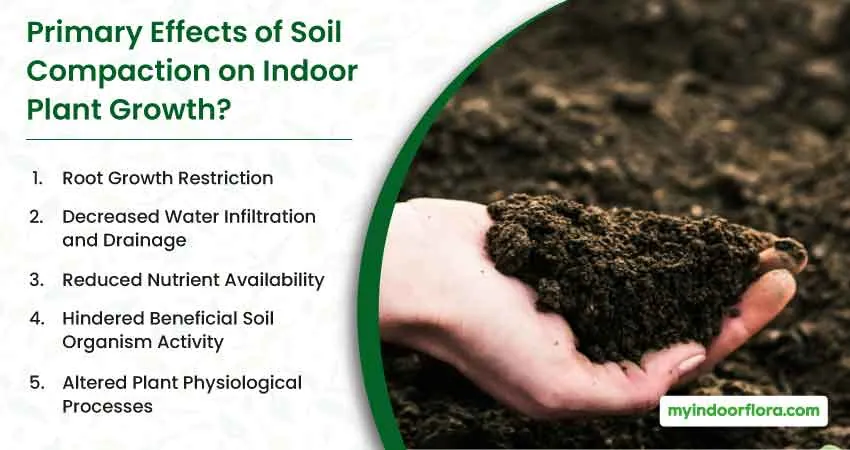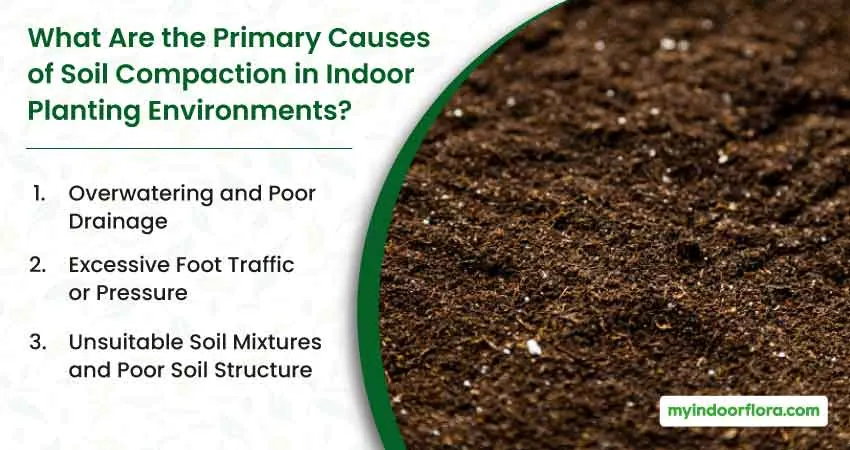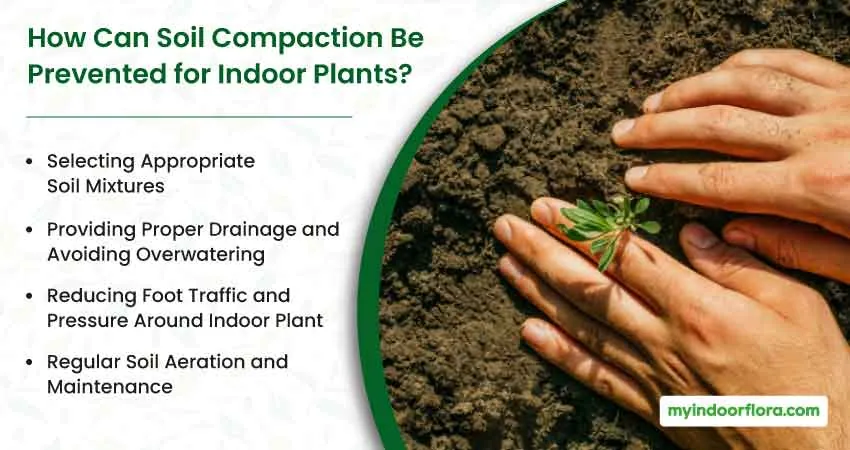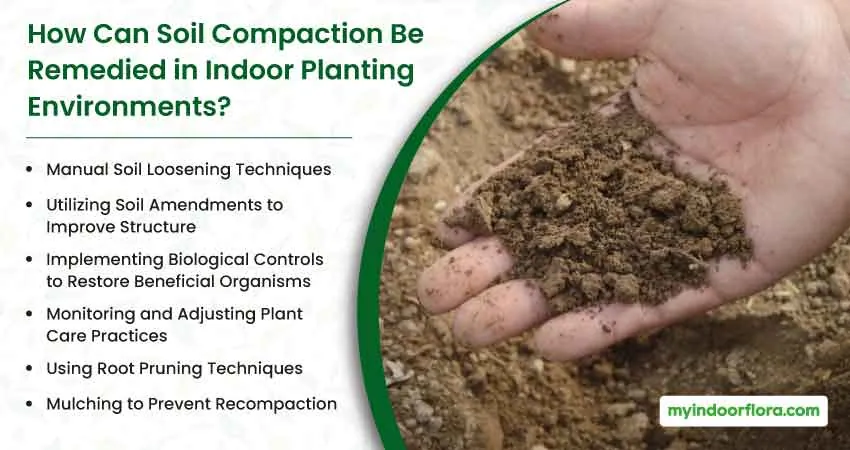Soil compaction is a critical issue that affects the growth and health of indoor plants by hindering root expansion, limiting water infiltration and drainage, reducing nutrient availability, and altering plant physiological processes.
As indoor gardening continues to gain popularity, with an estimated 30% of U.S. households participating in some form of indoor plant cultivation, addressing the negative effects of soil compaction has become increasingly important.
In this comprehensive guide, we will explore the primary effects of soil compaction on indoor plants, drawing on scientific research, expert opinions, and practical tips. We will also discuss the main causes of soil compaction and delve into effective prevention and remediation strategies to help you maintain a thriving indoor garden.
Primary Effects of Soil Compaction on Indoor Plant Growth?

Soil compaction can negatively impact indoor plant growth in several ways. Let’s explore the main effects of soil compaction on indoor plants and the consequences for their growth and health.
1. Root Growth Restriction
Compacted soil restricts root expansion, leading to reduced root biomass and limited nutrient and water uptake. This, in turn, increases the plant’s susceptibility to pests and diseases.
Impaired Root Expansion
When soil particles are compressed, the space available for roots to grow and expand is reduced. As a result, the roots may become stunted, twisted, or even break as they attempt to navigate the densely packed soil.
Reduced Root Biomass
A study published in the journal Plant and Soil found that compacted soil reduces the total root biomass. This limitation restricts the plant’s ability to acquire sufficient nutrients and water, ultimately affecting its overall growth and productivity.
2. Decreased Water Infiltration and Drainage
Compacted soil can lead to overwatering risks, root rot, and insufficient oxygen availability. It can also cause imbalanced nutrient absorption, further impairing plant growth.
Overwatering Risks and Root Rot
When soil is compacted, water infiltration and drainage are negatively affected. Excess water remains in the soil, which can lead to root rot – a common issue in indoor plants.
Insufficient Oxygen Availability
A lack of oxygen in the soil can inhibit root respiration, leading to impaired nutrient and water uptake. This ultimately results in stunted growth and decreased overall plant health.
3. Reduced Nutrient Availability
Soil compaction can also hinder nutrient availability for indoor plants by reducing soil aeration, impairing nutrient uptake by roots, and causing imbalanced nutrient ratios.
Reduced Soil Aeration and Nutrient Release
Compacted soil restricts the movement of air and water, which are essential for the release of nutrients from organic matter. This limited nutrient release can lead to nutrient deficiencies in the plants.
Hindered Nutrient Uptake by Roots
Compacted soil makes it difficult for roots to penetrate and access the nutrients they need. Moreover, limited oxygen availability can impede root function, further restricting nutrient uptake.
Imbalanced Nutrient Ratios
An imbalance in nutrient ratios can result from compacted soil, as some nutrients may be less available than others. This can lead to deficiencies and negatively affect plant growth.
4. Hindered Beneficial Soil Organism Activity
Compacted soil can negatively impact the populations of beneficial microbes and other soil organisms, impairing symbiotic relationships between plants and microbes and increasing the prevalence of harmful organisms.
Reduced Populations of Beneficial Microbes
Beneficial microbes, such as mycorrhizal fungi and nitrogen-fixing bacteria, play a vital role in plant growth and health. However, compacted soil can limit their movement, reproduction, and overall population size.
Impaired Symbiotic Relationships
Compacted soil can disrupt the symbiotic relationships between plants and beneficial soil organisms. These relationships are essential for nutrient exchange and overall plant health.
Increased Prevalence of Harmful Organisms
Compacted soil may favor the growth of harmful organisms, such as root-feeding nematodes, which can further stress and damage the plants.
5. Altered Plant Physiological Processes
Soil compaction can also alter various plant physiological processes, including stunted growth, increased susceptibility to environmental stresses, and altered photosynthetic efficiency.
Stunted Growth and Reduced Yields
As a result of the various factors previously discussed, such as restricted root growth, nutrient deficiencies, and impaired symbiotic relationships, compacted soil can lead to stunted plant growth and reduced yields.
Increased Susceptibility to Environmental Stresses
Plants growing in compacted soil are more susceptible to environmental stresses, such as temperature fluctuations, pests, and diseases, as their overall health and vigor are compromised.
Altered Photosynthetic Efficiency
Soil compaction can indirectly affect photosynthetic efficiency by limiting nutrient availability and altering root function. This can lead to reduced energy production and, ultimately, decreased growth.
What Are the Primary Causes of Soil Compaction in Indoor Planting Environments?

Understanding the primary causes of soil compaction in indoor planting environments can help prevent and address the issue effectively. The main causes include overwatering, excessive foot traffic or pressure, and unsuitable soil mixtures.
1. Overwatering and Poor Drainage
One of the primary causes of soil compaction is overwatering. Excessive water can cause soil particles to move closer together, leading to compaction. Poor drainage in the planting container can exacerbate this issue.
2. Excessive Foot Traffic or Pressure
In larger indoor planting environments, such as greenhouses or indoor gardens, foot traffic can be a significant contributor to soil compaction. The weight and pressure from walking on or near the soil can compress it, leading to the issues discussed above.
3. Unsuitable Soil Mixtures and Poor Soil Structure
Using an unsuitable soil mixture for indoor plants can contribute to soil compaction. A soil mixture with poor structure or inadequate organic matter content may become compacted more easily, leading to reduced plant growth and health.
How Can Soil Compaction Be Prevented for Indoor Plants?

Preventing soil compaction is crucial for maintaining healthy, thriving indoor plants. Here are some strategies for preventing soil compaction in indoor planting environments.
Selecting Appropriate Soil Mixtures
Choosing the right soil mixture for indoor plants is essential for preventing compaction. A well-draining soil mixture with a high organic matter content, such as a mix containing peat moss or coconut coir, can help maintain optimal soil structure and reduce the risk of compaction.
Providing Proper Drainage and Avoiding Overwatering
Ensure that the planting containers have adequate drainage to prevent waterlogging and soil compaction. Additionally, monitor the moisture levels in the soil and water plants appropriately to avoid overwatering.
Reducing Foot Traffic and Pressure Around Indoor Plants
Minimize walking on or near the soil in indoor planting environments to reduce soil compaction. If possible, use designated pathways and avoid placing heavy objects on the soil surface.
Regular Soil Aeration and Maintenance
Regular soil aeration can help prevent compaction by maintaining optimal soil structure and promoting healthy root growth. Use aeration tools, such as a soil probe or hand cultivator, to gently loosen the soil without damaging the roots.
How Can Soil Compaction Be Remedied in Indoor Planting Environments?

Addressing soil compaction is crucial for ensuring the health and growth of indoor plants. In this expanded section, we’ll dive deeper into the various strategies for remedying soil compaction, including expert opinions, scientific research, and practical tips.
Manual Soil Loosening Techniques
Gently loosening compacted soil using a hand cultivator, fork, or similar tool can improve soil structure and aeration. According to James Urban, a renowned landscape architect and soil expert, careful manual loosening of the soil is an effective way to alleviate compaction without damaging the roots. When loosening the soil, work from the outer edges of the root zone toward the center to minimize root disturbance.
Utilizing Soil Amendments to Improve Structure
Incorporating organic matter, such as compost, well-rotted manure, or leaf mold, into the compacted soil can help improve its structure and promote better drainage and aeration. A study published in the European Journal of Soil Biology found that adding organic matter to compacted soil could significantly enhance its physical properties and promote plant growth. In addition to organic matter, other soil amendments like perlite or vermiculite can be added to improve drainage and prevent compaction.
Implementing Biological Controls to Restore Beneficial Organisms
Introducing beneficial soil organisms, such as mycorrhizal fungi and nitrogen-fixing bacteria, can help restore the soil’s health and improve its structure. These organisms can be introduced through inoculants or by incorporating organic matter that supports their growth. Dr. Elaine Ingham, a prominent soil microbiologist, emphasizes the importance of a healthy soil food web in combating soil compaction. By fostering a diverse and robust community of soil organisms, you can improve soil structure and nutrient availability, enhancing plant growth and health.
Monitoring and Adjusting Plant Care Practices
Regularly monitoring the health of your indoor plants and adjusting your care practices as needed can help address soil compaction. Ensure that you are watering appropriately, providing adequate nutrients, and maintaining optimal environmental conditions to promote healthy plant growth and reduce the risk of soil compaction.
Using Root Pruning Techniques
In some cases, root pruning can help alleviate soil compaction and stimulate new root growth. This technique involves carefully cutting back the roots of the plant to encourage the development of new, healthy roots. A study published in the journal HortScience found that root pruning could effectively mitigate the negative effects of soil compaction on tree growth. While this method may not be suitable for all indoor plants, it can be an effective strategy for larger plants or trees grown indoors.
Mulching to Prevent Recompaction
Once soil compaction has been addressed, it’s essential to prevent recompaction. Applying a layer of mulch, such as bark chips, straw, or coco coir, around the base of the plant can help maintain soil structure and prevent compaction. Mulching also helps retain moisture, suppress weeds, and regulate soil temperature, further contributing to the overall health of the indoor plants.
By utilizing these strategies, you can effectively remedy soil compaction in indoor planting environments, promoting healthy and thriving indoor plants.
Conclusion
Soil compaction can have significant negative effects on indoor plant growth and health. By understanding the primary causes and consequences of soil compaction, you can implement effective prevention and remediation strategies to ensure your indoor plants thrive. Encourage further research and education on the topic, and don’t hesitate to seek advice from experts and fellow gardeners to help you maintain a healthy, flourishing indoor garden.
